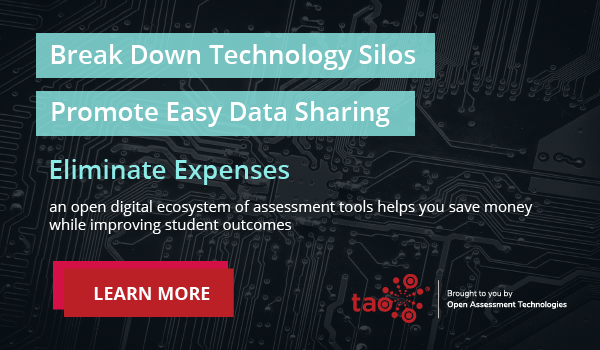A driver for innovation, open standards play an important role in promoting better access to educational technology. They are the underpinning of an interoperable, plug-and-play EdTech ecosystem. When used as a building block in digital learning environments, open education standards allow institutions to centralize user access to technology, unlock data silos and share learning content freely across applications.
Today, there are over 30 different educational technology standards recognized by the IMS Global Learning Consortium. However, there are a few most common open standards that enable an end-to-end, interoperable assessment ecosystem to deliver the learning experiences students and teachers deserve.
QTI: Question & Test Interoperability
Assessments and test content are valuable assets that institutions have invested time and resources into. However, all too often a lack of standardization in assessment tools prevents institutions from monetizing these assets by locking them away into proprietary systems. Ultimately, this also leads to complicated data silos as different EdTech tools are unable to freely exchange test and student information.
The QTI standard ensures that an institution’s assessments, item banks and testing data are accessible across the entire learning ecosystem, and even exportable across different QTI-based assessment platforms. For institutions, using technology certified in this open education standard means they can rest assured that they will maintain 100% ownership of their content, no matter how their digital learning environment evolves.
Technology enhanced items (TEIs) built on the QTI PCI standard also provide a more engaging learning experience by involving students in multi-step problem solving that measures 21st century skills. With the data collected, educators can ultimately provide faster feedback to students and gain insight into opportunities for adjusting teaching and assessment strategies.
OpenID Connect
There are two common open standards for authentication that enable users to sign into their assessment platforms: OpenID Connect (OICD) and Security Assertion Markup Language (SAML). OICD enables a single sign-on experience, allowing students and teachers to access multiple applications, like their LMS and assessment platform, with a single set of credentials. When each user only has one set of credentials, user management throughout the end-to-end assessment process becomes much simpler, faster and more secure.
LTI: Learning Tools Interoperability
Choosing assessment technology that supports the LTI standard is crucial for creating an interoperable EdTech ecosystem that evolves with today’s learners. LTI provides a consistent way to connect rich learning applications into one secure system, like an LMS. For students, LTI offers access to a centralized learning hub, where they can interact with their materials, submit assignments, take assessments and keep track of grades. For educators, a digital learning environment driven by LTI opens up possibilities for seamless data exchange to better pinpoint instruction to student needs.
The latest version of LTI, LTI 1.3, relies on OpenID Connect for authentication, and also provides an extra layer of security during the assessment process to ensure that no testing or student data is compromised.
OneRoster
“OneRoster is the standard specification for securely sharing class rosters and related data between a student information system (SIS) and any other system, typically a content application or learning information system (LMS).” — IMS Global Learning Consortium
OneRoster is an open education standard that further enables institutions to build a holistic digital learning environment by making student rostering faster and more accurate than when done manually. With accurate rosters, publishers can prevent errors like missing student accounts and assigning incorrect class groups, which can be major stumbling blocks to using online assessment resources in the classroom.
Caliper Analytics
The Caliper Analytics standard helps institutions to collect meaningful data from their learning and assessment applications to gain a holistic picture of student learning and teaching, end-to-end. They use this data to help inform:
- Curriculum, program or course design
- Student enrollment and retention strategies
- Student interventions
- Personalization
When used as part of an entire assessment ecosystem, these open education standards make it even easier for institutions to continuously improve upon their education strategies. Institutions can also start to directly measure the impact their digital learning environment has on improving learning outcomes for students.
—
As schools gear up to return to the classroom this fall, providing the flexible, sophisticated and secure learning experiences students and educators need is the top priority. While the lack of standardization in some EdTech tools has made this difficult in the past, today, the world’s leading institutions are turning to open education standards as the foundation for an interoperable EdTech stack.
Click here to learn more about how TAO’s certifications in IMS open standards can help you create a connected ecosystem that unites technologies and promotes innovation.


